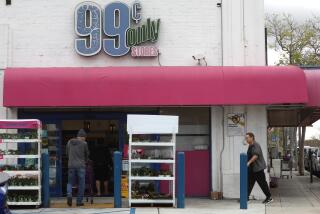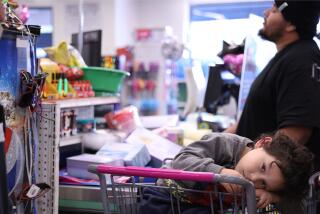Looks as if Retailers Wonât Get Their Wish : Sales: Amid some bright spots, last-minute spending is light. Analysts estimate that the seasonâs revenue will be 1% to 3% over last yearâs.
Last-minute shoppers squeezed into malls and neighborhood stores on Sunday, but sales remained too light to rescue most retailers from a lackluster holiday season.
Both nationally and in Southern California, analysts estimated that stores over the full holiday season would show slim sales gains, in the range of 1% to 3%, from a year earlier.
Among the disappointed retail companies was Dayton Hudson Corp., the parent of chains such as Target Stores and Mervynâs.
Retailers were jubilant at Westminster Mall in Orange County, where many store managers said sales had rebounded strongly this holiday season from a disappointing 1994.
âI think this store had its best December ever,â said Brian Gancherov, manager of a Radio Shack electronics store in the mall. âWeâll probably be up 30% from last year.â
Gancherov said shoppers have been snapping up cellular phones, as well as IBM personal computers, which Radio Shack began carrying just a few months ago after ending a retail agreement with another computer manufacturer, AST Research Inc.
âWithout these items weâd probably be down,â Gancherov said, adding that the $2,000 computers have been selling at the rate of one per day.
The story was largely the same around the corner at Going to the Game, a store that sells uniforms and other clothing items emblazoned with the logos of professional sports teams.
Anthony Aleman, a salesman at the store, said sales are up at least 30% from a year earlier, and that shoppers are more ready to buy big-ticket items.
âBefore, $16 for a shirt was too much,â Aleman said. âNow theyâre getting it all, whatever they can get their hands on.â
The best-selling items are jerseys, jackets and hats with Dallas Cowboys logos, he said. The store began the season with hundreds of Cowboys items, but by Christmas Eve that stockpile had been reduced to five Cowboys caps.
That meant the store had sold about 100 Cowboys jerseys for $45 apiece, Aleman said, as well as 30 jackets for $100 apiece and more than 100 hats for $19 each.
âI think people want to bring back the meaning of Christmas [at least] for retailers,â said Aleman, 20.
Fueling the storeâs success this season are shoppers such as Rachel and Ruth Maiten, 20-year-old twins from Huntington Beach. Ruth emerged from Going to the Game with an $80 Miami Dolphins jacket for her ex-boyfriend. âHeâs going to get me something too,â she explained. âDonât worry about that.â
Ruth said she spent about $500 on gifts this year, about $300 less than she spent last year. âRent,â she said. âI moved out this year.â
Her sister, Rachel, said she too had spent about $500, which was about $300 more than she had spent last year. âNew job, new money,â she explained.
For the Maiten twins, it seems, everything evened out this Christmas.
Although the past weekâs results exceeded expectations, they were ânot enough to make up for slower sales in the first part of the holiday season,â company spokeswoman Gail Dorn said. The company, whose Target chain is the biggest nonfood retailer in California, said sales of electronic goods and jewelry were particularly weak.
After surveying several Southland malls, retail analyst Richard E. Giss of the Deloitte & Touche accounting firm proclaimed that âthere are crowds out there, but they arenât gargantuan, as retailers had hoped for.â
Giss noted that some retailers this weekend already appeared to be slashing price tags to what would normally be post-Christmas levels.
On the other hand, the revitalized Sears, Roebuck & Co. reported that its Southwest region--which is dominated by California--showed the strongest gain among its six U.S. divisions.
Moreover, last week was the best sales week nationally in the history of the company, the nationâs No. 3 retailer. Even so, the company said its sales gains for the full holiday shopping season, although ahead of much of the industry, would fall below the 8% increase posted for 1994.
In downtown Los Angeles, the Broadway shopping district was bustling Sunday at noon, with Santa Claus making balloon sculptures, sidewalk artists hawking sketches and Spanish-language music blaring from rival electronics stores.
But at Hannahâs Gift Shop, few customers were standing in the small aisle between a table laden with inexpensive toys and walls hung thick with purses, backpacks and suitcases.
âThis year is very bad. I think because the majority of my customers are low-income people, minorities, I think they just donât have enough money,â said owner Sang Park as his daughter, 3-year-old Hannah, snoozed in the back room. âIn America, thereâs a problem. The big companies are growing bigger, and the small businesses are worse.â
Maria Delgado, who has worked at the Broadway Wear House selling Leviâs jeans for a quarter-century, said this season was better than last, though most customers buy only bargains. Down the block at the Jewelry Mart, Jerry Frounjian from Booth No. 23 said business has been bad for five years.
âIf you ask everybody else, people would say itâs better than last year, but people forget the past,â Frounjian said.
At the Northridge Fashion Center, which reopened in July after remodeling necessitated by the January, 1994, earthquake, few shoppers were toting more than a single package.
Inside George Allen Shoes, which was largely empty, manager Constance Marchetti attributed the absence of customers to impulse buying at less expensive shops. âThe people who buy $10 watches thatâll break in a week wonât come into our store,â she said.
Contributing to this report were Times staff writers Jodi Wilgoren in Los Angeles, David E. Brady in the San Fernando Valley and Greg Miller in Orange County.
More to Read
Inside the business of entertainment
The Wide Shot brings you news, analysis and insights on everything from streaming wars to production â and what it all means for the future.
You may occasionally receive promotional content from the Los Angeles Times.







